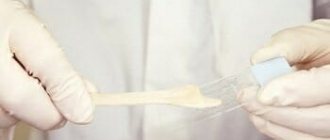Glucose is the main source of energy for the body's cells and the only source of energy for the brain and cells of the nervous system. A healthy body maintains a certain level of glucose in the blood. The balance of glucose in the blood depends on the hormones of the pancreas: insulin and glucagon. Insulin promotes the absorption of glucose by the body's cells and the formation of its reserves in the liver in the form of glycogen. Glucagon, on the contrary, mobilizes glucose from storage in order to, if necessary, increase blood glucose levels.
In what cases is a glucose test usually prescribed?
Typically, glucose levels are determined when a carbohydrate metabolism disorder is suspected. The most common cause of chronic high blood glucose (hyperglycemia) is diabetes mellitus. It is important to check fasting glucose during clinical examination for healthy people, since diabetes can be asymptomatic for several years and is diagnosed already at the stage of complications.
A glucose test (otherwise called “blood sugar”) is used to screen healthy individuals, to identify patients with prediabetes and diabetes, and when examining pregnant women.
Low glucose levels (hypoglycemia) can be life-threatening, and acute hypoglycemia can lead to coma and death of brain cells.
Several sequential blood glucose measurements are taken during a glucose tolerance test. In this case, the patient is first measured on an empty stomach, and then given a so-called “sugar load”, after which the glucose level is measured after 1 and 2 hours. The glucose tolerance test (OGTT) is not performed in medical laboratory offices because the patient must be under the supervision of a physician while performing the test. The OGTT (oral glucose tolerance test) can only be done in patients whose fasting glucose level does not exceed 7 mmol/l.
When is it necessary to take a blood sugar test?
First of all, the analysis is prescribed to patients who feel constant fatigue, lethargy, and who do not have the strength to engage in any physical activity. This condition of the human body may indicate an insufficient amount of glucose. Often such patients experience sweating and unreasonable trembling throughout the body. Sometimes patients cannot eliminate feelings of anxiety or severe hunger on their own.
It should be noted that the main indication for a blood sugar test is a suspicion of an increase or decrease in its level in the body.
What do the test results mean?
Elevated fasting blood glucose levels can be a sign of various carbohydrate metabolism disorders. Such test results are possible in case of diabetes mellitus, impaired glucose tolerance and the test was not taken on an empty stomach. The degree of increase in glucose levels should be assessed by a doctor. Fasting glucose more than 7.0 mmol/L or more than 11.1 mmol/L when taken at any time, regardless of food intake, is considered a sign of diabetes mellitus.
Reduced blood glucose levels may be a consequence of inadequate use of glucose-lowering drugs. Hypoglycemic conditions may be associated with the presence of a pancreatic tumor that produces glucagon - glucagonoma.
Rules for preparing for analysis
Before taking tests, the following is contraindicated:
- engage in intense mental and heavy physical work;
- to be nervous;
- smoke (at least for an hour);
- drink alcoholic beverages (for 1-2 days);
- take medication;
- brush your teeth;
- chew gum;
- exercise;
- carry out physiotherapeutic procedures and massage;
- subject the body to fluorography, x-ray and ultrasound examination.
The best time to donate blood is between 8 and 11 am.
If you do not follow these rules, tests may show elevated glucose levels even in the absence of diabetes.
It is also necessary to rest for 10-20 minutes and wash your fingers before donating blood.
If you are taking any medications to treat chronic diseases, you must inform your endocrinologist about this so that the doctor can take into account the effects of the drugs when interpreting the results. It is also necessary to notify the doctor about colds and other existing infections: they can also distort the results.
If blood is donated on an empty stomach, then for 8-12 hours before the test you should not eat food or sweet drinks, you can only drink water. If the analysis involves donating blood after a meal, then you need to eat 1-1.5 hours before taking blood. The timing of meals does not have any effect on the results of the glycohemoglobin analysis.
If the doctor has prescribed a “sugar load,” then you should not have breakfast before the test, and you must take pre-purchased pure glucose (75 grams) for the test. Based on the data obtained during this study, hypoglycemic and hyperglycemic indices are calculated.
It is recommended to conduct repeated studies in the same laboratory, at the same time of day and under the same conditions as the first time.
Analysis for sweets
Type 2 diabetes mellitus can easily be called a disease of civilization, and in more than half of cases it occurs without symptoms. We don’t feel how sugar undermines our blood vessels year after year. But if you find out about it in time, you can control its level, often even without medication - with diet and physical activity. Diabetes does not come immediately - first there is an impairment of glucose (sweet) tolerance, or prediabetes. This is where you need to catch the problem.
Candidate of Medical Sciences, endocrinologist Dmitry SHEMYAKIN spoke about how to analyze your own sweetness.
How often should you take a blood sugar test?
Before 40 years old, once every 5 years is enough, after forty – once every 3 years. But if there are cases of diabetes in the family, blood must be tested for glucose annually.
Which analysis is more accurate - from a vein or from a finger? And can you trust your home glucometer?
Each method has its own normal limits: for blood from a capillary (finger) it is 3.3–5.5 mmol/l, and for blood from a vein the upper limit of normal is 6.1 mmol/l. The glucometer gives fairly accurate readings and is considered a reputable home analyzer. But in the laboratory the test is still carried out using professional equipment.
If your sugar levels are high, does that mean it's diabetes?
| 3 FACTS ABOUT DIABETES – Heredity plays an important role in the development of both types of diabetes. – 90% of cases are type 2 diabetes. – The definition of “sugar” is not accidental: there is also diabetes insipidus associated with brain pathology. With it there is characteristic thirst and diabetes, but the sugar level remains normal. |
Not at all necessary. Perhaps the blood was not donated on an empty stomach. Suck a lollipop or drink a cola - this is quite enough for the sugar level to increase. Sometimes there are mistakes: the blood was taken for a long time, the aim of the device was “out of whack.” Therefore, the golden rule: if your sugar levels are elevated for the first time, after a few days, retake the test twice in another laboratory.
And if the result is borderline, slightly above the norm?
Do you mean between 5.5 and 6.0 mmol/L on a finger prick test? This condition is called impaired glucose tolerance (IGT). In this case, you need to do another test - “with a sugar load”. First, your fasting blood sugar level is determined, then you drink 75 g of glucose in the form of syrup and donate blood again after 2 hours. Do not eat, drink or smoke for 2 hours between tests; physical activity should be dosed - it is advisable not to move a lot, but also not to lie down. By the way, the sugar load test is not taken on an empty stomach, but after breakfast.
Are the stress test results different from the normal test results?
Yes, the indicators are higher: up to 7.8 mmol/l is normal; 7.8–11.00 mmol/l – prediabetes; above 11.1 mmol/l – diabetes.
If you managed to catch prediabetes, is that a plus?
What a great one! After all, this means that the development of type 2 diabetes can be greatly slowed down. Of course, you have to work, but the result is worth it. The two main goals in the fight against prediabetes are to lose excess weight and give up sweets. An endocrinologist or nutritionist will help you choose the right diet and eliminate unnecessary foods, and a fitness trainer will suggest a set of exercises.
What is the difference between type 2 diabetes and type 1 diabetes?
Type 1 diabetes is insulin-dependent, caused by impaired insulin production.
It definitely requires the use of insulin. Type 2 diabetes, or non-insulin-dependent diabetes, is a penalty for diet and rhythm of life, caused by impaired tissue sensitivity to insulin and does not require insulin therapy. It accounts for more than 85% of all cases of diabetes. Published: April 4, 2021
Survey objectives
The analysis is intended to detect the presence of diseases of various origins, be it diabetes mellitus or the presence of a tumor. In addition to diagnostics, the analysis results are also used to prevent the occurrence of diseases. That is why this analysis is performed in completely different cases when an adult visits a doctor.
In addition, there are several types of blood glucose testing:
- General blood analysis. It is not the amount of sugar that is examined, but rather the emphasis is placed on the level of hemoglobin and blood clotting.
- Glucose tolerance test.
It takes about two hours:
- Initially, blood is taken before eating;
- then the subject drinks an average of 100 ml of sweetened syrup;
- Then blood is donated three more times: after an hour, 1.5 hours, and the last draw - after 2 hours.
If the pancreas is functioning normally, the glucose readings will be elevated during the first sampling, and will decrease with each subsequent result. This analysis is carried out when the purpose of the study is to identify prediabetes, as well as the possible presence of latent diabetes in a pregnant woman.
- Analysis for glycated hemoglobin. Shows hemoglobin, whose molecules interact with glucose. So, with an increased sugar content there will be more glycated hemoglobin.
- Also, the purpose of the study may include changes in glucose per day. With this method, the algorithm for changing a person’s sugar readings is controlled.
- There are situations when there is no time to wait to go to the clinic, and the analysis needs to be done quickly. In such cases, the express method is used. It is carried out using a glucometer. Mainly used to control sugar status in diabetic patients. The advantage of this method is that it is fast. Disadvantage - possible difference from the results obtained in a laboratory test.
Methods for determining blood sugar levels (how blood is donated for sugar)
There are several ways to determine your blood sugar level:
- Determination of sugar level in capillary blood (in blood from a finger). Capillary blood is a mixture of the liquid part of the blood (plasma) and blood cells. Blood is drawn in the laboratory after a puncture of the ring or any other finger.
- Determination of sugar level in venous blood plasma . In this case, blood is taken from a vein, then it is processed, and plasma is released. A blood test from a vein is more reliable than from a finger, since pure plasma without blood cells is used.
- Using a glucometer . A glucometer is a small device for measuring blood sugar levels. It is used by patients with diabetes for self-control. Glucometer readings cannot be used to diagnose diabetes mellitus, since it has a small error depending on external conditions.
Glucose tolerance test
To clarify the diagnosis, some patients are prescribed a glucose tolerance test, or sugar curve. It is carried out in several stages. First, the patient takes a fasting blood sugar test. He then drinks a solution containing 75 g of glucose over a few minutes. After 2 hours, the blood sugar level is determined again.
Preparing for such a stress test is no different from preparing for a regular blood sugar test. During the analysis, in the interval between blood draws, it is advisable to behave calmly, not actively move and not be nervous. The glucose solution is drunk quickly, within no more than 5 minutes. Since such a sweet solution may cause vomiting in some patients, you can add a little lemon juice or citric acid to it, although this is not advisable.
How to take a blood sugar test?
Before you begin preparing for the analysis, you must first decide on the methodology for carrying it out, because each analysis has its own nuances.
In medical practice, an express method for determining blood glucose levels is often used, which is carried out with a special device called a glucometer. To do this, a drop of blood is placed on the test strip, and after a few seconds the device shows the level of the organic compound. This type of analysis has the advantage of being fast, but it may not be particularly accurate. Patients with diabetes need to have such a device at home and, if their condition is poor, measure the level themselves to avoid sudden surges in blood glucose.
If the patient needs more accurate indicators, then laboratory testing can be used.
To determine blood sugar, doctors take biological material from a patient’s finger or vein and send it to a laboratory for testing. As a rule, the result is ready within a few hours.



